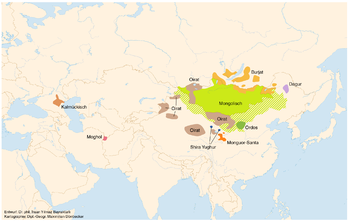- Mongolic languages
-
Mongolic Geographic
distribution:Mongolia; Inner Mongolia and regions close to its border, Xinjiang, Gansu, Qinghai (China); Buryatia and Kalmykia (Russian Federation) Linguistic classification: Altaic (controversial) - Mongolic
Subdivisions: Central MongolicShirongolicDagurMogholiISO 639-5: xgn The Mongolic languages are a group of languages spoken in East-Central Asia, mostly in Mongolia and surrounding areas plus in Kalmykia. The best-known member of this language family, Mongolian, is the primary language of most of the residents of Mongolia and the Mongolian residents of Inner Mongolia, China with an estimated 5.2 million speakers.[1] Mongolic is sometimes grouped with Turkic, Tungusic and possibly Korean and Japonic as part of the larger Altaic family.[2]
Contents
Classification
- Middle Mongolian (depending on classification spoken from the 13th until the early 15th[3] or late 16th century[4])
- Classical Mongolian
Contemporary Mongolic:
- Dagur (=Daur) (ca. 100,000 speakers)
- Central Mongolic
- Khamnigan (ca. 2000 speakers)
- Buryat (Dialects: Bargu, Khori, Aga, Ekhirit, Unga, Nizhne-Udinsk, Barguzin, Tunka, Oka, Alar, Bohaan, Bulagat) (ca. 300,000 speakers)
- Mongolian proper (including Khalkha basically in Mongolia and Chakhar, Khorchin, Kharchin, Baarin, Shilin gol in Inner Mongolia) (ca. 5-6 mio. speakers)
- Ordos (ca. 100,000 speakers)
- Oirat (Varieties: Torgut, Dörbet, Olot (Ööld, Elyut, Eleuth), Zakhchin, Mingat, Bayad, Kalmyk, Khoshut (Khoshuud), Alasha) (ca. 300,000 speakers)
- Shirongolic (part of a Gansu–Qinghai Sprachbund)
- Eastern Yugur (Shira Yugur) (ca. 3000 speakers)
- Monguor (also known as Tu; dialects: Mongghul (Huzhu), Mangghuer (Minhe)) (ca. 100,000+30,000 speakers)
- Bonan (ca. 10,000 speakers)
- Dongxiang (Santa) (ca. 600,000 speakers)
- Kangjia
- Moghol (=Mogholi) (unclear whether there are speakers left)
The classification and speaker numbers above follow Janhunen[5] except that Mongghul and Mangghuer are treated as a sub-branch[6] and that Kangjia has been added.[7] In another classificational approach,[8] there is a tendency to call Central Mongolian a language consisting of Mongolian proper, Oirat and Buryat, while Ordos (and implicitly also Khamnigan) is seen as a variety of Mongolian proper. Within Mongolian proper, they then draw a distinction between Khalkha on the one hand and Southern Mongolian (containing everything else) on the other hand. A less common subdivision of Central Mongolian is to divide it into a Central dialect (Khalkha, Chakhar, Ordos), an Eastern dialect (Kharchin, Khorchin), a Western dialect (Oirat, Kalmyk), and a Northern dialect (consisting of two Buryat varieties).[9] The broader delimitation of Mongolian may be based on Mutual intelligibility, but an analysis based on a tree diagram such as the one above faces other problems due to the close contacts between e.g. Buryat and Khalkh Mongols during history thus creating or preserving a dialect continuum. Another problem lies in the sheer comparability of terminology as Western linguists use language and dialect, while Mongolian linguists use the Grimmian trichotomy language (kele), dialect (nutuγ-un ayalγu) and Mundart (aman ayalγu).
Proto-Mongolic
Proto-Mongolic, the ancestor language of the modern Mongolic languages, is very close to Middle Mongolian, the language spoken at the time of Genghis Khan and the Mongol Empire. It is also very close to Common Mongolic, the language from which all contemporary Mongolic varieties can be explained and which contains some features not (yet) present in Middle Mongolian.
The languages of Donghu, Wuhuan and Xianbei might be related to Common Mongolic, namely Tabghach (the language of the founders of the Northern Wei dynasty) and Khitan. In the case of Tabghach, the surviving evidence is very sparse, thus one can state that a generic relationship is possible. In the case of Khitan, there is rich evidence, but most of it is written in the two Khitan scripts that have as yet not been fully deciphered. However, from the available evidence it has to be concluded that a generic relationship to Mongolic is likely.[10]
Notes
- ^ Svantesson et al. 2005: 141
- ^ e.g. Starostin et al. 2003; contra e.g. Vovin 2005
- ^ Rybatzki 2003: 57
- ^ Poppe 1964: 1
- ^ Janhunen 2006: 232-233
- ^ Slater 2003
- ^ Siqinchaoketu 1999
- ^ eg Sečenbaγatur 2005: 193–194
- ^ Luvsanvandan 1959 quoted from Sečenbaγatur et al. 2005: 167–168.
- ^ Janhunen 2003b: 391–394, Janhunen 2003a: 1–3
References
- Janhunen, Juha (ed.) (2003): The Mongolic languages. London: Routledge.
- Janhunen, Juha (2003a): Proto-Mongolic. In: Janhunen 2003: 1–29.
- Janhunen, Juha (2003b): Para-Mongolic. In: Janhunen 2003: 391–402.
- Janhunen, Juha (2006): Mongolic languages. In: Brown, K. (ed.): The encyclopedia of language & linguistics. Amsterdam: Elsevier: 231-234.
- Luvsanvandan, Š. (1959): Mongol hel ajalguuny učir. Mongolyn sudlal, 1.
- Poppe, Nicholas (1964 [1954]): Grammar of Written Mongolian. Wiesbaden: Harrassowitz.
- Rybatzki, Volker (2003): Middle Mongol. In: Janhunen 2003: 47–82.
- Sechenbaatar, Borjigin (2003): The Chakhar dialect of Mongol – A morphological description. Helsinki: Finno-Ugrian society.
- [Sechenbaatar] Sečenbaγatur, Qasgerel, Tuyaγ-a, B. ǰirannige, U Ying ǰe. 2005. Mongγul kelen-ü nutuγ-un ayalγun-u sinǰilel-ün uduridqal. Kökeqota: ÖMAKQ.
- Siqinchaoketu [=Sečenčoγtu] (1999): Kangjiayu yanjiu. Shanghai: Shanghai Yuandong Chubanshe.
- Slater, Keith (2003): A grammar of Mangghuer. London: RoutledgeCurzon.
- Starostin, Sergei A., Anna V. Dybo, Oleg A. Mudrak (2003): Etymological Dictionary of the Altaic Languages. Leiden: Brill.
- Svantesson, Jan-Olof, Anna Tsendina, Anastasia Karlsson, Vivan Franzén (2005): The Phonology of Mongolian. New York: Oxford University Press.
- Vovin, Alexander (2005): The end of the Altaic controversy (review of Starostin et al. 2003). Central Asiatic Journal 49.1: 71–132.
External links
- The LINGUIST List MultiTree Project: Mongolic Family Tree
- Ethnologue report on Mongolic languages
- Ethnic groups of Mongolia
- Ethnic map of Mongolia
- Mongolic languages at the Open Directory Project
Altaic languages 1 Not always recognized as Altaic languages. See also Buyeo languages. Categories:
Wikimedia Foundation. 2010.

